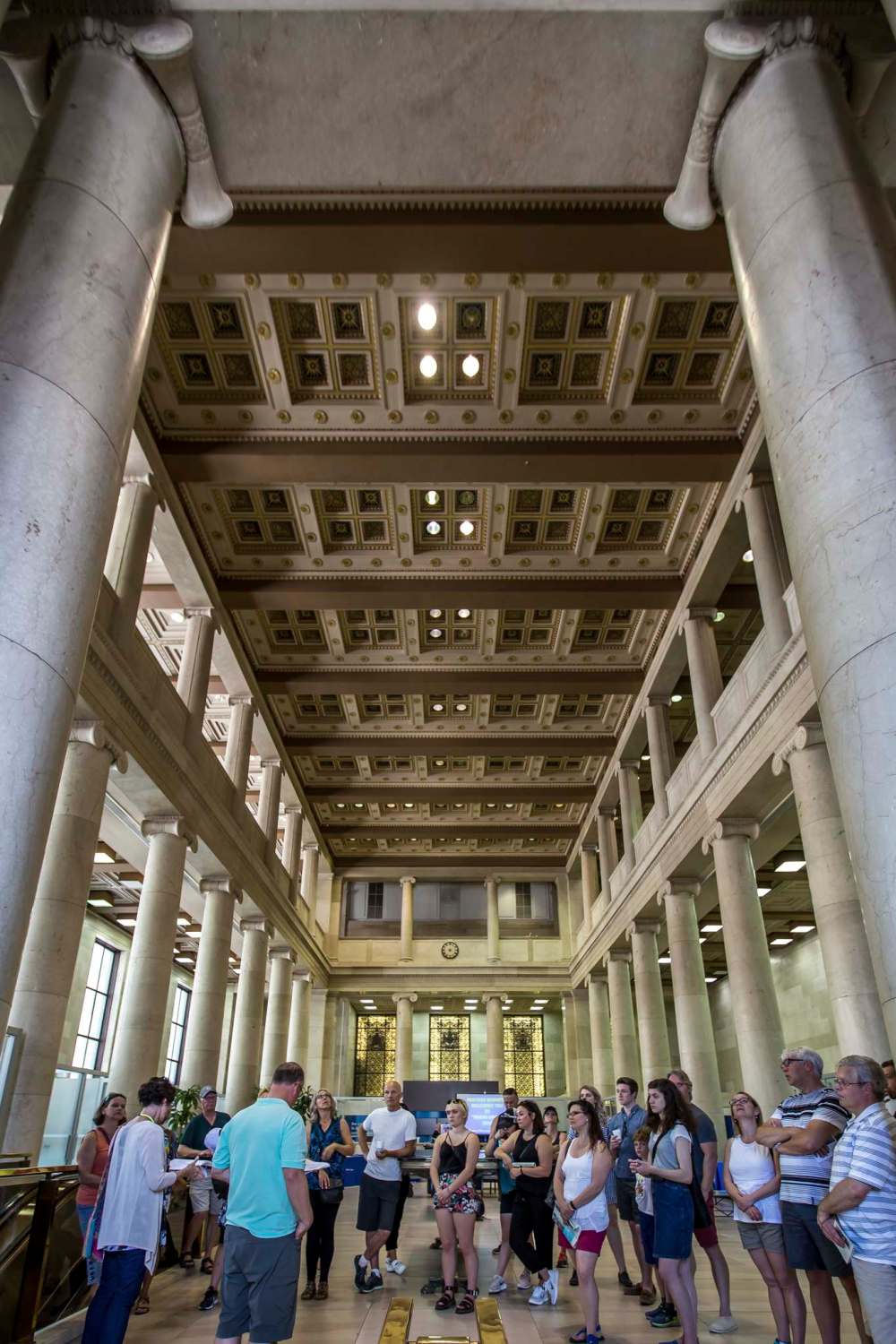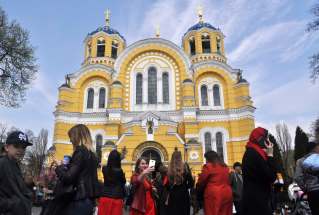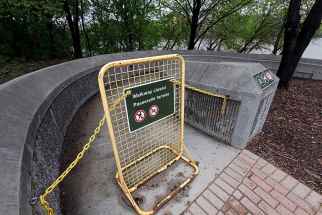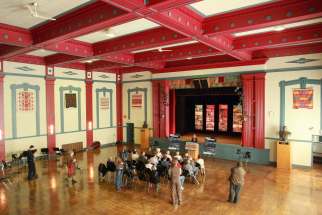Strike while the doors are open The year 1919 takes centre stage during annual viewing of city's famous buildings
Read this article for free:
or
Already have an account? Log in here »
To continue reading, please subscribe:
Monthly Digital Subscription
$0 for the first 4 weeks*
- Enjoy unlimited reading on winnipegfreepress.com
- Read the E-Edition, our digital replica newspaper
- Access News Break, our award-winning app
- Play interactive puzzles
*No charge for 4 weeks then price increases to the regular rate of $19.00 plus GST every four weeks. Offer available to new and qualified returning subscribers only. Cancel any time.
Monthly Digital Subscription
$4.75/week*
- Enjoy unlimited reading on winnipegfreepress.com
- Read the E-Edition, our digital replica newspaper
- Access News Break, our award-winning app
- Play interactive puzzles
*Billed as $19 plus GST every four weeks. Cancel any time.
To continue reading, please subscribe:
Add Free Press access to your Brandon Sun subscription for only an additional
$1 for the first 4 weeks*
*Your next subscription payment will increase by $1.00 and you will be charged $16.99 plus GST for four weeks. After four weeks, your payment will increase to $23.99 plus GST every four weeks.
Read unlimited articles for free today:
or
Already have an account? Log in here »
Hey there, time traveller!
This article was published 24/05/2019 (2395 days ago), so information in it may no longer be current.
The 16th edition of Doors Open Winnipeg falls at an auspicious time in the city’s history, corresponding as it does with the 100th anniversary of the 1919 Winnipeg General Strike.
Event preview
Doors Open Winnipeg
• Saturday and Sunday
• Various locations
• Free admission
• Complete list of attractions at doorsopenwinnipeg.ca
Celebrations of that event — when 35,000 workers, from iron workers and pressmen to telephone operators and movie projectionists, walked off the job for six weeks to demand eight-hour work days, the right to collective bargaining and better pay — have seen an uptick in interest in Winnipeg’s history, including sites that played a role in the city-wide work stoppage.
One of those is the Ukrainian Labour Temple, 191 Pritchard Ave., which also celebrates its 100th anniversary in 2019. The neo-classical building, constructed with volunteer labour, was raided during the general strike, as it was a rallying centre for the trade union movement, and housed a press that was used to print strike bulletins.
As part of Doors Open, the annual event run by Heritage Winnipeg that provides a peek inside some of the city’s storied buildings and celebrated cultural institutions, the temple will be hosting tours that explore its sometimes controversial history on Saturday and Sunday from 11 a.m. to 5 p.m., as well as providing Ukrainian entertainment.
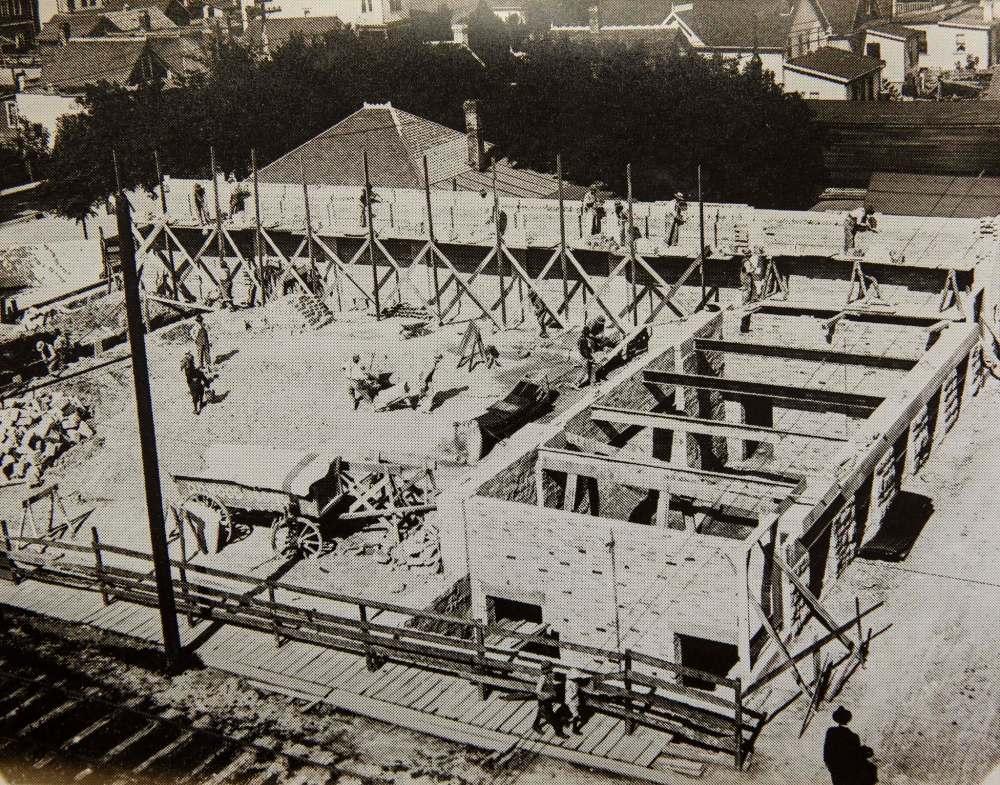
The entertainment aspect is something Cindy Tugwell, executive director of Heritage Winnipeg, says is becoming a bigger part of the event, bolstering the notion that Doors Open is more than an architectural tour. It has added an arts and cultural element that’s become more prominent every year and aims to attract a wider range of participants.
For instance, Seven Oaks Met student Grace Lovatt has penned a children’s book, illustrated with original watercolours, about a teenage Tommy Dtoouglas walking the streets of Winnipeg during the general strike. It will be available at the Vaughan Street Jail on Saturday or the Millennium Centre on Sunday for a donation of $5. There’s also a colouring book by Robert Sweeney that explores the history of public transportation, available at the Rail Museum.

“It’s multifaceted,” Tugwell says. “I think people might think it’s just old buildings, but we have the human rights museum, we have the Royal Canadian Mint. We want things that are architecturally significant, historically significant and culturally significant.”
It’s not just about edifices, either: Doors Open also curates a slate of walking and biking tours, from Haunted History to the Murals of Transcona, as well as new 1919-themed offerings, including a Winnipeg General Strike bus tour (which is sold out) and Strike! The Walking Tour, which departs from Old Market Square at 10 a.m., 11:30 a.m., 1:30 p.m. and 4 p.m. on Saturday.
New additions for 2019
Doors Open Winnipeg has added many heritage locations to this year’s event. Read more about some of the new options to explore:
• Centre du Patrinome
• Dawson Building
• Deutsche Vereinigung Winnipeg
• First Lutheran Church
• Fortune Block
• Hungarian Canadian Cultural Society
• Patent 5 Distillery
• Station 8 Firehall
Doors Open Winnipeg has added many heritage locations to this year’s event. Below are a selection of new options to explore (for a complete list of locations, guided walking and bike tours and outdoor events, see doorsopenwinnipeg.ca).
• Centre du Patrinome, 340 Provencher Blvd. (Saturday, 9 a.m. to 4 p.m.): In the heart of Old Saint-Boniface, this building, with a wall built from the original elements of the Empire Hotel (circa 1881), houses archival collections documenting francophone and Métis presence in Western Canada.
• Dawson Building, 171 McDermot Ave. (Saturday and Sunday, 9 a.m. to 5 p.m.): Built in 1921, it housed the publisher of the Grain Trade News, the Beekeeper and Poultry magazine and others. It’s been home to nightclub Desoto’s, as well as Pockets and the Coyote club. In 2015 it was renovated; now Forth Cafe and Lounge, a gallery space and offices fill it.
• Deutsche Vereinigung Winnipeg, 11 Charles St. (Saturday, 11 a.m. to 5 p.m.): Currently known as the German Society of Winnipeg Clubhouse, it was built in 1912 as the Hebrew Free School, considered one of the best Talmud Torahs in North America.
• First Lutheran Church, 580 Victor St. (Saturday, noon to 4 p.m.): Founded by Icelandic immigrants in 1878, this West End church has a mandate to feed the community, with hospitality programs and food banks running all year.
• Fortune Block, 230 Main St. (Satuday and Sunday, 11 a.m. to 5 p.m.): The fifth-oldest building in downtown, this block on the corner of Main and St. Mary Avenue was built by Mark Fortune in 1882. The building includes the expanded Times Change(d) High and Lonesome Club.
• Hungarian Canadian Cultural Society, 443 Selkirk Ave. (Saturday, 11 a.m. and 5 p.m.): This community cultural centre in the North End invites the public to enjoy folk dances, traditional foods and cultural artifacts.
• Patent 5 Distillery at the Dominion Express Building, 108 Alexander Ave. (Saturday and Sunday, 11 a.m. to 5 p.m.): This new distillery offering gin and vodka (and whiskey in the future) can be found in a former stable built in 1905; it’s outfitted with oak panelling, stained-glass windows and doors of the former Oak Room at the St. Regis Hotel.
• Station 8 Firehall, 325 Talbot Ave. (Saturday, noon to 5 p.m.): Built in 1906, Station 8 functioned as a firehall until 1972, after which it is became home to a boxing club, ambulance depot, dance studio and youth drop-in centre. Now it’s the office for Riverwood Church Community; the church won a Preservation Award for Excellence from Heritage Winnipeg in 2015.
On Saturday, Manitoba Unions present the Solidarity Forever Parade, which runs from Market Avenue and Lily Street in the Exchange District to Memorial Park in front of the Manitoba legislature, followed by a concert in the park featuring Sierra Noble, James Keelaghan, Heather Bishop, Red Moon Road, Nathan Rogers and more.
“That’s great for us, because we’ve got the Vaughan Street Jail, we’ve got the (legislature), we’ve got Government House, we’ve got the Manitoba Archives, so we have that whole hub,” Tugwell says of the venues around Memorial Park. “You get once-in-a-lifetime celebratory events like (the strike) and people ask, ‘Why are we celebrating this?’ They start to learn and that’s an interesting segue into other arteries of Doors Open.”
Heritage Winnipeg received a substantial federal grant from Commemorate Canada to help celebrate the general strike. “So everything that we do has to be digitized so that it’s available for people across the country,” Tugwell says. “The nice thing about that is that our history becomes Canada’s history.”
However, you don’t have to be a 1919 nut to enjoy the event. The list of venues throwing open their doors this weekend runs the gamut from churches and community halls to theatres and museums. Many of them will be offering entertainment, including performances by the Manitoba Underground Opera at Théâtre Cercle Molière in St. Boniface and flamenco dancers at the Millennium Centre on Main Street.

“Every single year it’s grown consistently,” Tugwell says, explaining that the event, which drew about 30,000 attendees last year, was intially centred downtown but now includes buildings all over the city, such as the 17 Wing Community Chapel in St. James, the Charleswood Historical Society Museum and Eglise Sainte-Norbert.
“We don’t really have to go too far; they come to us now and say they want to be involved.”
She explains that because of Winnipeg’s rapid growth at the turn of the last century — in the early 1900s, it was the third-largest city in Canada — it has a degree of significant architecture that’s unusual for a city its current size, including a collection of historical warehouses that’s second only to Barcelona’s.
“The Exchange was abandoned,” she explains. “It was too expensive to demolish these buildings so people walked away and they were just used for storage. The Core Area Initiative in the ‘80s gave a monetary incentive to be rehabilitated, but that is one of the reasons Winnipeg is really extraordinary, because we’re one of the only cities in North America that has this.”
jill.wilson@freepress.mb.ca
Twitter: @dedaumier

Jill Wilson writes about culture and the culinary arts for the Arts & Life section.
Our newsroom depends on a growing audience of readers to power our journalism. If you are not a paid reader, please consider becoming a subscriber.
Our newsroom depends on its audience of readers to power our journalism. Thank you for your support.

